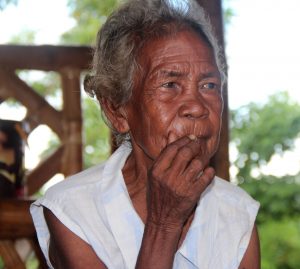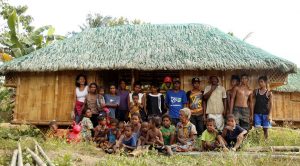
The Ati once ruled and roamed Panay island and its majestic Madia-as mountain range as if it were their own. But time moves on. Circumstances change.
The Ati, like other Indigenous Peoples who were once a virtual part of the land, no longer belonged. They’ve become unwanted, dispossessed – their proud, nomadic lifestyle reduced to sacada farming, itinerant vending, or even alms-begging from urban dwellers.
Driven by the harsh winds of chance and circumstance, most Atis have had no permanent address, much more a place called home. It is thus sweet irony and a blessing that a Super typhoon called Yolanda and a program called Kalahi -CIDSS will combine to provide a permanent shelter to some of these woeful wanderers.
Among them is tribal chieftain Turko Eskonaand more than a handful of families in Barangay Caw-i, Batad town. Turko and his family once lived among the 171 Aeta families in Sitio Nagpana, Barangay Lipata, Barotac Viejo.Sitio Nagpana is a government-declared reservation covering 938 hectares of forest land, a watershed area with sections
identified for housing. Decades after it was established, however, the reservation has become crowded.
“Damo na didto gaestar sa Nagpana kag gutok na. Wala na mayo pangabuhian (There are many families living in Nagpana.It is already crammed. There are no more available jobs there),” recalled Turko who has since moved his family from Nagpana toBarangay Caw-i in nearby Batad town.
The move to Bgy. Caw-i has been a common practice for quite a number of Nagpana folk. But Turko had his own reasons.
Turko makes herbal medicines, remedies and cures from vines, barks and incense and peddles them in the municipalities ofEstancia, Batad and Balasan. He usually earns about P140 per day. On a good day, especially during market days, he may earn as much as P500. But traveling to and from these towns can be costly.
Clearly, his income from peddling is not even enough to provide food for his wife and his five children. Thus, when a family in Bgy. Caw-i allowed Turko to occupy part of their idle land for free, he jumped at the opportunity.
For a while, they led a stable life. His wife, Gilda, took her turn as a peddler while he worked as a farm laborer. Turko was also paid to do odd jobs for the neighbors.“There are a lot of jobs here if you work hard enough.”
Turko was even picked as tribal chieftain by the Atis in Bgy. Caw-i. Though he showed some leadership, he was chosen
most likely because he is the nephew of Gregorio Elosendo, the Ati chieftain inNagpana.
But the day came when the landowners needed the property. They had to move to another idle lot, also in Barangay Caw-i.
Misfortune struck anew when TyphoonYolanda destroyed their ramshackle home in 2013. Again, he had to move. He built yet another makeshift house, this time in the property of Caw-i Barangay captain Elmer Francisco.
Typhoon Yolanda’s stormclouds, however, also brought more than a silver lining for Turko and his fellow Atis in Bgy. Caw-i.
When the Kalahi-CIDSS program came to the community in the wake of typhoon Yolanda, the local barangay residents took the opportunity to identify the construction of permanent shelters for IPs.
The Atis were allowed to participate in the meeting. They also wanted to build the shelters immediately.
The program provided funding support for the purchase of five pre-fabricated houses specifically designed for the needs of the IPs. Each shelter, measuring 1.65 x 4.75or 7.84 square meters, accommodates one family. The toilet is separate from the pre-fabricated houses.

Kalahi-CIDSS provided P604,684.73 as community grant for the permanent shelters, while P8,815.27 was provided by the barangay as their counterpart. BarangayCaptain Francisco donated a 600-meter lotto serve as a site for permanent shelters.
We are thankful to the lowlanders for prioritizing our needs and to Kalahi-CIDSSfor providing us the grant.” Turko said. # (MMC/Kalahi-CIDSS/DSWD-6)
